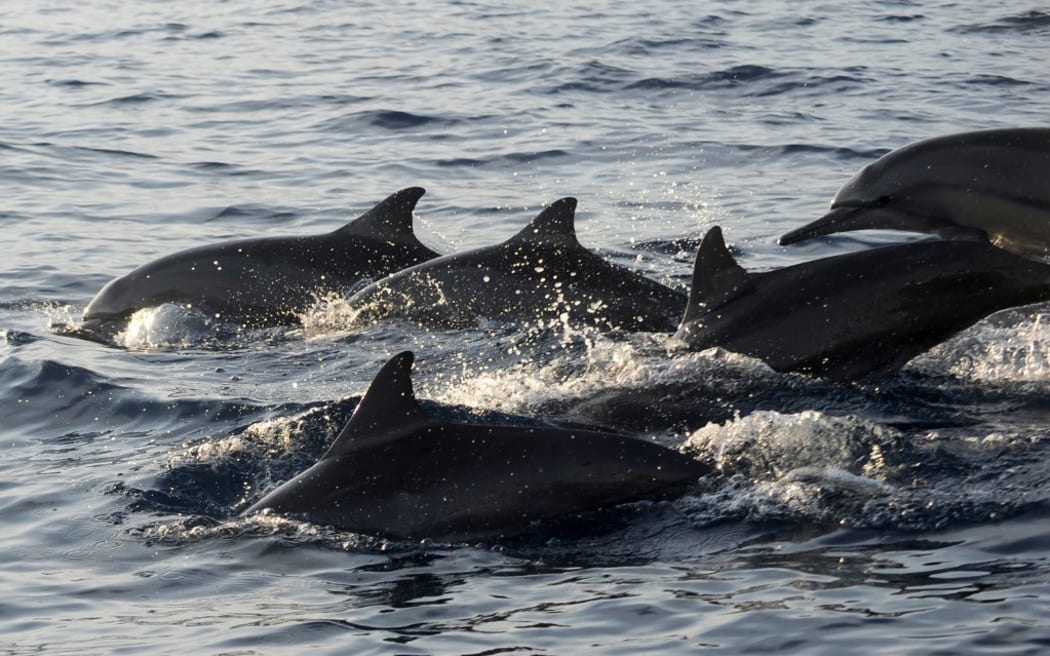
Many child viewers may have found the content deeply disturbing, the viewer who complained said. File pic Photo: AFP or licensors
A scene in a marine wildlife documentary that showed a female dolphin being trapped and mated with by a group of unknown male dolphins upset children, a viewer who complained said.
The Broadcasting Standards Authority (BSA) agreed the episode of the New Zealand-made series, Our Big Blue Backyard, was incorrectly classified as having a G, general rating, when it should have been one of PG, parental guidance.
The scene in question showed a female dolphin attempting to flee a group of male dolphins who ultimately trapped her at the surface of the water near the Manawatāwhi Three Kings Islands, and mated with her.
The authority said the impression of a struggle was created by the thrashing of dolphin bodies at the surface, audio of dolphin cries played while this was happening, and in one of the shots male dolphin genitalia was clearly visible, along with one male briefly entering the female.
Chris Radford complained to the authority that the broadcast, which aired at 7.30pm on TVNZ 1 earlier this year, should have been rated PG or at least had a warning for parents so they could decide whether to let children watch it.
"Many child viewers may have found this content deeply disturbing, and the programme should have been rated PG to indicate to parents that guidance and explanation may be required for children watching," he said.
"While I am happy to concede that animal behaviour should not be seen through the lens of human social norms, the purpose of ratings is to protect vulnerable viewers from being exposed to content that they may find disturbing.
"In the context of human social norms many viewers could and did find the content disturbing and further parental guidance was subsequently required as a result."
TVNZ did not uphold the complaint and said it was season three of the popular documentary series and was therefore reasonable to assume viewers would be aware of the material that would be shown, including, sometimes, "confronting facts of nature, including animal deaths".
It said the sexual encounter was of great importance to the long-term survival of the Manawatāwhi dolphins and was therefore of high relevance to the programme which focuses on fragile ecosystems and colonies around New Zealand.
The footage "simply shows normal dolphin mating behaviour in the wild", and the encounter was "depicted in a manner suitable for a G-rated programme: it was factual, educational, and was not unduly dramatised".
TVNZ also pointed out the episode screened on TVNZ 1 which had an adult target audience.
The scene featured six minutes before the end of the hour-long broadcast at 8.30pm, the end of children's normally accepted viewing time.
In its decision released on Wednesday, the BSA said the music and descriptions used by the narrator created a tense and dramatic atmosphere.
This included phrases such as "aggressive gang of young males", "battle-scarred oceanic males", "she's trapped at the surface and the males take turns", and that it was a "seemingly brutal assault".
The authority said the scene complained of could be particularly affecting for children.
"The sinister music, the language used by the narrator, and the audio of dolphin cries, which could readily have been interpreted as the distressed cries of the female, added dramatised tension to the scene.
"The scene also dealt with mature themes, being animal sexual behaviour, and included graphic images of this behaviour, and a technical description of the female dolphin's 'built-in birth control'.
"While the acts themselves may have been 'acts of nature' and potentially innocuous, the dramatised elements of the broadcast and the treatment of the footage created tension which may not have been inherent in the act itself.
"In this sense, even though earlier scenes signposted the topic of the dolphins' mating and breeding challenges, the particular content and dramatic impact of the final scene were unexpected in our view and there was no pre-warning it may be distressing for younger viewers."
The BSA said its research identified animal harm or torture as one of the most common types of content that children found upsetting.
It said while the episode was not necessarily unsuitable for child viewers given the strong educational element, it concluded the themes and content in the final dolphin scene should have been subject to the guidance of a parent or an adult.
The panel upheld the complaint that the broadcast breached the children's interests standard of the Code of Broadcasting Standards, but no order or penalty was made.
This story was first published by the New Zealand Herald.


